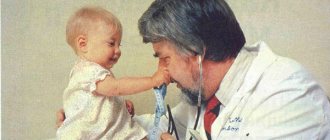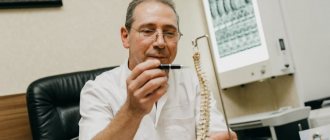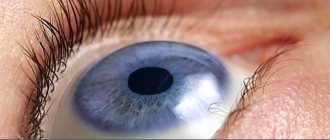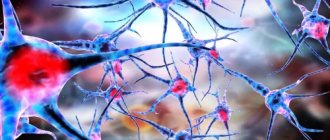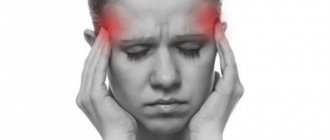There are 6 types of headaches:
- Muscle tension
- Vascular
- Neuralgic
- Liquorodynamic
- Functional or psychalgia
- Mixed
Here is an interesting plate based on statistical data from outpatient visits to a pediatric neurologist at our clinic.
Please note that complaints of headaches appear in children in preschool age, with a subsequent increase.
| Age/ Nosology | 0-1 year | 1-3 years | 4-7 years | 8-10 years | 11-14 years old | 15-17 years old |
| Headaches, unspecified | 7% | 9% | 16% | 18% | ||
| Tension type headaches | 3% | 12% | 18% | 24% | ||
| Vascular headache | 0.3% | 0.8% | 2% | 10% | 18% | |
| Migraine | 1% | 1% | 1% | 1% | ||
| Functional, including against the background of cerebrovascular disease | 2% | 4% | 6% | 9% |
Tension type headaches
(psycho-emotional or muscle pain) occur when the child’s psycho-emotional load does not match his capabilities (emotional-volitional or cognitive), which in turn increases the tone of the “emotional” muscles that are attached to the periosteum of the skull. This muscle pain is considered a headache. Now it becomes clear why this type of headache is characteristic of the age at which preparation for school begins, and increases exponentially by the time of passing the Unified State Exam.
Vascular headache
This is pain in response to stretching or inflammation of the vascular wall. There can be many reasons, from vascular abnormalities to banal vascular dystonia. Migraine is also a type of vascular headache, has characteristic clinical manifestations, and its cause is aseptic inflammation of the vascular wall.
Neuralgic headache
occurs when there is pressure on the nerve trunk, its branch or node, and after compression there is ischemia and pain. The reason for this may be post-traumatic or inflammatory swelling along the nerve, as well as any space-occupying formation. Neuralgic headache can also be of central origin, as a result of dysfunction of the nociceptive and antinociceptive systems of the brain.
In the occurrence of liquorodynamic headache
the main role is played by increased intracranial pressure. Intracranial pressure may increase with the appearance of additional formations, both liquid and solid, in the cranial cavity, which in turn compresses and/or displaces the meninges, blood vessels and nerves, causing pain. This may be a tumor, inflammation of the meninges of the brain (meningitis). Intracranial hypertension can also occur as a result of the appearance of any neoplasm that obstructs the outflow of cerebrospinal fluid from the cranial cavity.
Functional headache
most often has a psychogenic mechanism.
Mixed form, has mixed origin.
We have analyzed six types of headaches, which, in turn, have different causes.
To figure out what exactly is causing your child’s headaches, you need to contact a pediatric neurologist, who, after a neurological examination, will decide whether you need consultation with a related specialist and may prescribe additional examination methods.
In the children's building of the clinic
You will be able to get advice from experienced specialists, as well as conduct all the necessary examinations to identify the causes of headaches in your child.
Information prepared for you by:
Razina Elena Evgenievna – pediatric neurologist, epileptologist, functional diagnostics doctor, leading specialist of the clinic. Conducts a reception in the Children's building on Usachev.
Why does my child have a headache?
Headache (cephalalgia) is any unpleasant sensation that occurs in the area from the eyebrows to the back of the head.
This is one of the few sufferings that is familiar to almost everyone. When visiting a neurologist, every fifth patient complains of a headache. For a long time it was believed that cephalalgia in children, especially young children, was rare. Actually this is not true. It’s just that kids cannot describe how they feel when they have a headache, and older children don’t like to complain about it and even hide this fact from their parents.
The most common causes of cephalalgia in children are mental, physical and emotional stress, vegetative-vascular dystonia, migraine, head injuries, inflammatory diseases in the head and neck area. It is worth paying attention to how much time your child spends near the computer or TV. Prolonged strain on the organs of vision and hearing can cause headaches.
Often, cephalalgia occurs in a child who spends a long time in a stuffy room or eats irregularly. By the way, children who do not attend kindergarten are more likely to experience pain. This is due to the fact that parents do not always adhere to the daily routine for the child in a family setting, while in kindergarten there is timely nutrition and naps during the day.
Sometimes a severe and especially sudden headache can signal problems with the brain or central nervous system. Also, cephalalgia may indicate emotional or psychological problems, or a viral disease: sore throat, cold, flu.
Parents should remember that headache complaints are subjective and difficult to verify. There are “pain phenomena” that allow us to judge the presence and nature of the pain syndrome. It is necessary to analyze how a child behaves with complaints of cephalgia. With complaints that deserve attention, the background mood is reduced, interest in the environment weakens, the child tends to lie down. There is a serious facial expression, sometimes knitted eyebrows, and folds above the bridge of the nose. Sometimes crying or moaning occurs. Pallor or redness of the face, dark circles under the eyes, and cold fingers are striking.
Headache in infants is manifested by general anxiety, sleep disturbance, refusal to eat, regurgitation, and fever. In severe cases, a monotonous “brain” cry occurs. At 1-2 years old, instead of complaining of a headache, children talk about fatigue and want to lie down. The whites of their eyes may turn red and they may yawn. Children from 3 to 7 years old can already distinguish cephalalgia and describe it.
Nowadays, schoolchildren constantly experience stress and overwork. Among all types of cephalgia in adolescents, muscle tension headache occurs in 80% of cases and more often. Children complain of a feeling of “tightening” around the head, tension and soreness in the scalp muscles, and discomfort when combing their hair.
At the age of 12-13, hormonal changes begin in the child’s body, affecting the functioning of his blood vessels and psycho-emotional state, which can provoke the development of vascular headaches. A large dependence on changes in weather conditions is revealed.
A possible cause of recurring headaches may be migraine. The more likely a child’s migraines are to suffer from it, the more their adult relatives are exposed to it. An attack can be triggered by hunger, certain foods, such as cheese, chocolate. The headache is accompanied by nausea, in severe cases - vomiting, “spots” appear before the eyes, and photophobia.
To clarify the nature of cephalgia in many children, there is a need to conduct laboratory and instrumental studies, which makes it possible to exclude space-occupying brain lesions and the presence of concomitant diseases.
Causes of headaches in children
Headache can occur at any age. Acute or chronic, it can occur in a specific area or spread to the entire surface of the head. Its exact localization, as well as the time of occurrence and the conditions under which it worsens, are of important diagnostic importance. One of the first criteria is the location of the headache, depending on this we can tentatively assume what caused it.
- Pain in the back of the head often occurs due to tension during the day. They can also be caused by pathologies in the cervical spine and various postural disorders.
- Discomfort in the temporal lobe often indicates autonomic disorders. Another cause of pain in the temples is diseases of the vascular system.
- Pain in the forehead is one of the manifestations of hypertension. It is also diagnosed with increased intracranial or intraocular pressure.
- Unilateral pain that completely covers half of the head is a sign of migraine. It is acute and occurs suddenly, regardless of the time of day and other factors.
Doctors at the Clinical Brain Institute specialize in diagnosing and treating children of any age, including newborns, who exhibit signs of headaches. Methods are selected individually, taking into account the characteristics of each patient.
Headache in a newborn
Headaches can be caused by birth trauma or fetal development disorders immediately before childbirth. They occur when there is insufficient oxygen supply to the newborn’s brain, which causes damage to individual cells and large nerve structures. Even if fetal development occurs normally throughout pregnancy, the following abnormalities may occur during labor and in the first few months of life:
- umbilical cord entanglement is a common complication;
- infectious diseases of the mother suffered during pregnancy;
- injuries and displacements of the vertebrae in the cervical region;
- congenital diseases of the cardiovascular system.
One of the dangerous causes of headaches in newborns is hydrocephalus, or dropsy of the brain. The disease is a violation of the circulation of cerebrospinal fluid (CSF) and leads to increased intracranial pressure, as well as constant compression of the tissues of the central nervous system.
Household reasons
Even a healthy child can have a headache. Constant fatigue, high stress at school and in extracurricular activities, stress and poor lifestyle are common causes of chronic headaches. Despite the fact that a child’s brain is capable of absorbing and processing a huge amount of information, the learning process must take place at a comfortable pace. In order to eliminate the simplest factors that can cause headaches, you should follow the basic rules:
- maintain a sleep schedule, provide the child with free time to play;
- spend time outdoors;
- provide regular healthy nutrition with the necessary supply of vitamins, including during the cold season;
- Minimize spending time in front of the monitor.
Tension headache is one of its most common types. It occurs not only in adults, but also in children at any age. First-graders (during adaptation to a new schedule), as well as adolescents 13-15 years old, are most often affected. Its causes are nervous tension, as well as prolonged stay in a sedentary position. A sedentary lifestyle and lack of exercise can also cause constant discomfort.
Blood pressure abnormalities
Chronic, pressing pain that often occurs in the front of the head often indicates a pressure disorder of various types. These indicators reflect the resistance of all types of fluids that are present in the human body, including blood, cerebrospinal fluid, and aqueous humor of the eyes. If their balance is disturbed, this leads to constant discomfort and compression of the surrounding tissues.
If signs of headache are detected, an examination is carried out to determine the following indicators:
- arterial pressure;
- intracranial pressure;
- intraocular pressure.
Hypertension is an increase in blood pressure. If the indicators change slightly, this rarely leads to acute headache and other clinical manifestations. However, from 13 to 15% of cases of pain in the head are the result of a hypertensive crisis, which can also occur in children. Constant filling of the arteries with blood leads to disruption of the mechanisms of regulation of cerebral circulation. The patient develops hyperemia (increased blood flow) to the brain, resulting in headache, nausea, deterioration of visual acuity and even loss of consciousness. The attacks usually end within 24 hours, but they are dangerous because they compress nerve tissue and reduce the supply of oxygen to them.
Increased intracranial pressure is diagnosed in most of the population, including children of any age. This indicator is represented by the resistance of several substances: the blood of the cerebral arteries, the cerebrospinal fluid of the ventricles and the brain tissue itself. It is impossible to measure it at home, and accurate data is obtained only when strictly necessary, using an invasive procedure for determining the speed of cerebrospinal fluid flow. It is worth understanding that minor fluctuations in intracranial pressure do not pose a danger.
Ocular hypertension in children can be a consequence of congenital or acquired diseases of the visual system, as well as injuries or improper selection of glasses and lenses. Pain occurs directly in the eyes, and then spreads along the trigeminal nerve to the temporal and frontal regions. Other symptoms also appear: lacrimation, decreased visual acuity, which are especially noticeable in bright light. If you suspect ocular hypertension in a child, you should consult an ophthalmologist.
Migraines in children
Migraine is an acute headache that occurs especially often in adolescents. It is difficult to establish its causes, and treatment consists of the timely use of systemic analgesics. It occurs in the form of an attack and can intensify at any time of the day. It can be determined by its main characteristics:
- a sharp headache, often one-sided, but can spread to the entire head or to individual areas;
- the duration of the attack is from 5-30 minutes to several hours;
- dizziness, pale skin;
- in some cases - nausea and lacrimation.
Migraine attacks are difficult to distinguish from other headache manifestations. If they occur frequently and last more than 60 minutes, you should seek medical help. Migraines can begin in adolescence and often subside over time. The only way to combat deterioration during attacks is to take painkillers. Only a doctor can choose the appropriate remedy, the most effective and at the same time safe for the child.
Vascular pathologies
Diseases of the heart and blood vessels in young children are often congenital. In adolescents, they may already be associated with poor lifestyle and nutrition, lack of physical activity and excess weight. When diagnosing headaches, the Clinical Brain Institute necessarily conducts studies to exclude the following pathologies:
- heart defects, various types of arrhythmia, heart failure;
- abnormalities in the development of blood vessels that participate in blood circulation in the brain;
- ischemia (insufficient blood supply) to the brain;
- aneurysms and other disorders of the structure of blood vessels;
- cerebral hemorrhages.
Our clinic has all the conditions for a full diagnosis of diseases of the cardiovascular system, including in newborns and children of primary preschool age. It should be understood that such patients are shown a number of restrictions in everyday life that will allow the disease not to progress, so it is important to detect them at an early stage.
Psychogenic headaches in a child
Psychogenic headaches are more common in children over 8-10 years of age, but can also occur at an earlier age. They are associated with emotional stress, conflict situations in the family or team, psychological pressure and any other stressful situations, often combined with insufficient physical activity. Children complain of a pressing headache and discomfort, in some cases nausea or visual disturbances. Attacks can last from several hours to several days; chronic psychogenic headaches are also distinguished. They are less intense than migraines, but can last for days. There is a clear relationship between headaches and the exacerbation of the stressful situation that provokes it.
Spinal diseases
The cervical spine is a mobile and at the same time vulnerable structure. Here are the arteries that carry blood rich in oxygen and nutrients to the brain. They are partially protected by bone fragments of the vertebrae, and blood flow is possible only if their integrity and correct location are maintained. If one of these conditions is violated, the vessels are compressed and blood flow slows down, leading to acute or chronic ischemia. Pain that occurs in the back of the head and can spread to the entire surface of the head can be caused by one of the following changes:
- osteochondrosis - thinning and decreased elasticity of intervertebral discs (the disease is associated with old age, but in practice it is diagnosed also in children and adolescents);
- curvature of the cervical spine;
- protrusion of intervertebral discs - violation of their location, the initial stage of a hernia;
- poor posture, prolonged stay in an unnatural position without movement;
- inflammation or spasms of the muscles of the cervical region.
Diagnosis of the cervical spine is included in the mandatory examination regimen for headaches. Also at the Clinical Brain Institute it is possible to analyze the level of blood circulation in the vessels that pass at this level.
Other reasons
It is important to determine the cause of a child’s headache, since the prescribed treatment regimen will depend on this. It is impossible to do this at home, but the doctors at our clinic are always ready to provide a full, informative consultation for parents. Painful sensations are not always an indicator of serious disorders and periodically occur in healthy children. Their reasons may be:
- incorrect selection of glasses or lenses;
- insufficient lighting while reading or doing homework;
- failure to maintain the recommended distance from the eyes to a book or monitor;
- sleep disorders;
- autonomic dysfunction is a syndrome that can manifest itself during intensive growth of a child.
Constant headaches can also indicate dangerous problems that require immediate treatment. Tumors and hematomas in brain tissue, vascular damage, trauma or infectious diseases (meningitis) - these conditions are rarely diagnosed, but are also taken into account during the examination.

